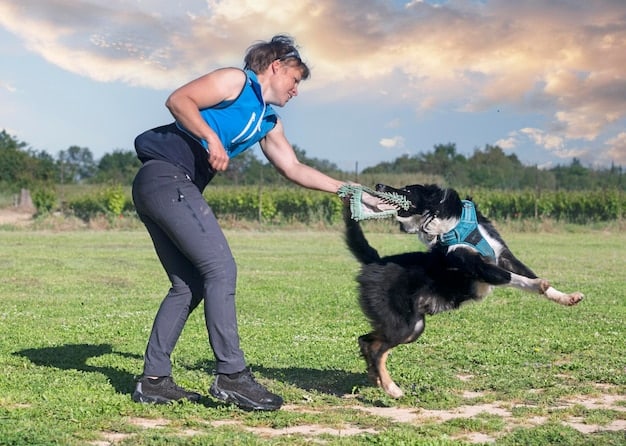Stop Dog Barking in 7 Days: A 2025 Training Guide

Stopping your dog’s excessive barking in under 7 days involves understanding the reasons behind the barking, implementing consistent training techniques, and providing ample mental and physical stimulation to reduce the urge to bark unnecessarily; this 2025 guide provides actionable steps for success.
Is your dog’s barking driving you (and your neighbors) crazy? You’re not alone. Many dog owners struggle with excessive barking, but the good news is that it’s often manageable. This guide, “**How to Stop Your Dog’s Excessive Barking in Under 7 Days: A 2025 Guide**,” provides practical strategies to help you regain peace and quiet.
Understand Why Your Dog Barks
To effectively address your dog’s barking, you first need to understand why they’re doing it. Barking is a natural form of communication for dogs, but excessive barking usually indicates an underlying issue. Identifying the trigger is the first step.
Common Reasons for Barking
Dogs bark for various reasons, and recognizing these can help you tailor your approach. Is it territorial, alarm, attention-seeking, or frustration?
Distinguishing Between Different Types of Barks
Learn to recognize the difference between a playful bark, an alert bark and a distress bark. This will help you respond appropriately and address the root cause.
- Territorial Barking: Often triggered by seeing or hearing someone near the property.
- Alarm Barking: Alerting you to potential threats.
- Attention-Seeking Barking: Demanding food, play, or attention.
- Frustration Barking: Often due to boredom, confinement, or lack of stimulation.
Understanding the ‘why’ behind the bark is paramount to developing an effective plan to curb excessive barking. Ignoring the root cause will likely lead to frustration for both you and your dog. With patience and observation you will be able to distinguish triggers and address them accordingly.

Implement Training Techniques
Once you’ve identified the cause of the barking, it’s time to implement training techniques. Consistency is key, and it’s essential to use positive reinforcement methods. This means rewarding your dog for good behavior rather than punishing them for barking.
The Power of Positive Reinforcement
Positive reinforcement focuses on rewarding desired behaviors, making them more likely to occur in the future. This approach is more effective and humane than punishment-based methods.
“Quiet” Command Training
Teaching your dog the “quiet” command can be incredibly effective. Start by triggering their barking, then use the command and reward them when they stop. Repetition is key.
- Start with a trigger (e.g., a knock on the door).
- When your dog barks, say “Quiet” firmly.
- The moment they stop, reward them with a treat and praise.
- Repeat the process several times a day.
By linking the sound of silence with a reward, your dog will quickly learn what’s expected of them. Don’t be discouraged if it takes time. Patience and consistency are essential when training any dog, especially with behavioral issues like barking.
Provide Mental and Physical Stimulation
A bored dog is far more likely to bark excessively. Providing ample mental and physical stimulation will help to reduce their urge to bark unnecessarily. Think of it as tiring them out, both mentally and physically.
The Importance of Daily Exercise
Regular exercise not only keeps your dog physically healthy but also helps to release pent-up energy that could otherwise manifest as barking. A brisk walk, a run in the park, or a game of fetch can all make a difference.
Engaging Activities to Reduce Boredom
Mental stimulation is just as important as physical exercise. Puzzle toys, training sessions, and interactive games can all keep your dog’s mind engaged and prevent boredom-related barking.
- Puzzle Toys: These toys require your dog to solve a problem to get a treat.
- Training Sessions: Even short training sessions can provide mental stimulation.
- Interactive Games: Games like hide-and-seek or fetch keep your dog engaged.
- Rotate toys regularly to keep your dog interested and engaged.
A tired dog is a good dog. By addressing both their physical and mental needs, you’ll find that your dog is less likely to bark out of boredom or frustration. It’s a simple yet effective approach to managing excessive barking.

Manage Environmental Triggers
Dogs often react to their environment, so managing triggers can be an effective way to reduce barking. This involves identifying what sets your dog off and making changes to minimize those triggers.
Identifying Barking Hotspots
Common environmental triggers include seeing people or animals outside the window, hearing noises in the hallway, or feeling confined. Identify the hotspots in your home that trigger barking.
Creating a Calm Environment
Once you’ve identified the triggers, take steps to minimize them. This could involve blocking your dog’s view of the outside world, using white noise to mask external sounds, or creating a safe and comfortable space where they feel secure.
- Block Views: Use curtains, blinds, or window film to prevent your dog from seeing outside.
- White Noise: A fan, white noise machine, or calming music can mask external sounds.
- Safe Space: Create a comfortable den where your dog feels secure and relaxed.
By taking control of your dog’s environment, you can significantly reduce the number of opportunities they have to bark. It’s about creating a space where they feel safe, secure, and less reactive to external stimuli.
Consider Professional Help
If you’ve tried various methods but are still struggling with your dog’s barking, it’s time to consider professional help. A certified dog trainer or veterinary behaviorist can provide personalized guidance and address any underlying behavioral issues.
When to Seek Expert Advice
If the barking is excessive, uncontrollable, or accompanied by other behavioral problems, it’s essential to seek professional help. A trainer or behaviorist can assess your dog’s behavior and develop a tailored plan.
Benefits of Working with a Trainer or Behaviorist
A professional can identify the root cause of the barking and provide targeted training techniques. They can also help you address any underlying anxiety or fear that may be contributing to the problem.
- Personalized Training: A trainer can develop a customized plan for your dog’s specific needs.
- Address Underlying Issues: A behaviorist can identify and treat underlying anxiety or fear.
- Objective Assessment: A professional can provide an unbiased assessment of your dog’s behavior.
Seeking professional help isn’t a sign of failure; it’s a responsible step in ensuring your dog’s well-being. With the right guidance, you can address the barking issue and create a happier, more peaceful home for both you and your furry friend.
Maintain Consistency and Patience
Consistency and patience are crucial for success. It takes time for your dog to learn new behaviors, and setbacks are normal. Stick with your training plan, celebrate small victories, and don’t get discouraged by occasional barking.
Why Consistency Matters
Dogs thrive on routine, and consistency helps them understand what’s expected of them. It’s essential to use the same commands, rewards, and consequences every time to avoid confusion.
Dealing with Setbacks
There will be times when your dog barks despite your best efforts. Don’t punish them for it; instead, calmly redirect their attention and reinforce the desired behavior. Remember, progress isn’t always linear.
- Stay Calm: Avoid getting frustrated or angry, as this can make the problem worse.
- Redirect Attention: Use a toy or treat to distract your dog from the trigger.
- Reinforce Good Behavior: Reward your dog when they stop barking and remain calm.
Training a dog requires commitment and understanding. By maintaining consistency and patience, you’ll gradually see improvements in your dog’s behavior. Remember to focus on the progress you’ve made and celebrate each small step forward.
| Key Point | Brief Description |
|---|---|
| 🤔 Understand the Why | Identify the triggers behind your dog’s barking. |
| 💪 Training is Key | Use positive reinforcement and the “quiet” command. |
| 🤸 Stimulation Matters | Provide mental and physical activities to reduce boredom. |
| 🏡 Manage the Environment | Minimize triggers by blocking views and masking sounds. |
Frequently Asked Questions
▼
While the title suggests under 7 days, realistic results depend on the dog’s temperament and the consistency of your training. You might see initial improvements within a week, but full control may take longer.
▼
Anxiety-related barking requires a different approach. Consult with a vet or behaviorist to address the underlying anxiety through medication or behavior modification techniques alongside training.
▼
Bark collars are controversial and should be used as a last resort, and only under the guidance of a professional trainer or vet. Positive reinforcement methods are generally more effective and humane.
▼
Train a different behavior when the doorbell rings, such as going to a specific spot and staying there. Reward them for this new behavior, and gradually they’ll associate the doorbell with going to their spot.
▼
Apartment living requires extra consideration. Focus on minimizing noise triggers, providing ample exercise, and engaging in indoor activities to keep your dog mentally stimulated and less prone to barking.
Conclusion
Stopping excessive barking requires a combination of understanding the underlying causes, implementing consistent training techniques, managing environmental triggers, and providing ample mental and physical stimulation. While it might take more than 7 days to achieve complete silence, these actionable steps will set you on the path to a quieter, more harmonious home in 2025.





